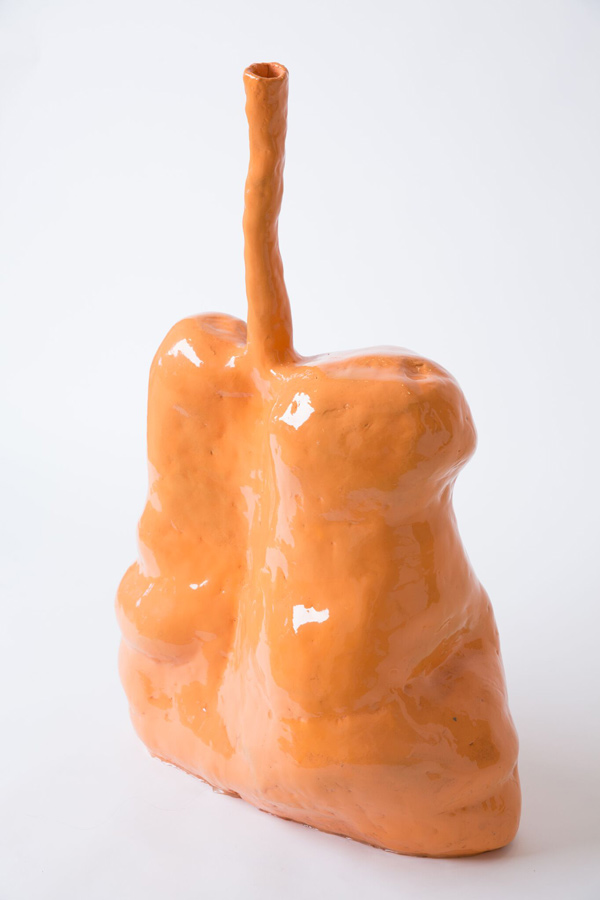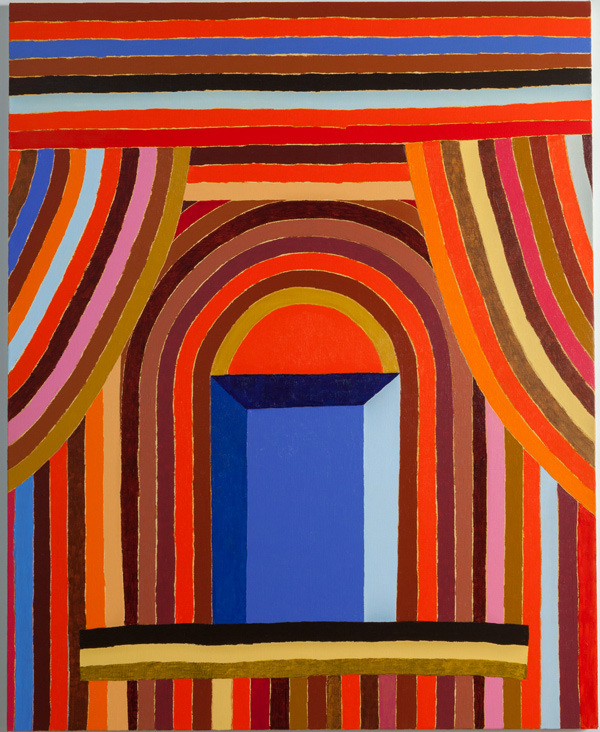“Knock-Kneed and Bow-Legged,” on view at Oakland’s Johansson Projects, stakes out territory in a harsh but brilliant realm where contradiction is the order of the day, and logical assumptions must be checked at the door. The works of painter Matt Kleberg imply a quirky unseen figurative presence, one that the anthropomorphized sculptures of Woody De Othello obligingly suggest.
Kleberg, with a funky take on Minimalist stripes referencing Frank Stella, creates an inviting world of brightly-hued concentric shapes in oil and oil stick on canvas, producing illusions of portals to some unknown dimension. With unusual and at times jarring color combinations, and a line quality and surface both attractive and repellent, Kleberg also posits the struggle between good and evil. Bats Out of Hell (2017) smolders with a palette in oranges, reds, alizarin, rust and browns, contrasting with a central rectangle of periwinkle blue suggesting a doorway. Horseshoe-shaped bands create the illusion of a proscenium arch, while inverted arcs along the sides suggest the parting of a curtain. Fire and Brownstone (2016), in verdant shades of green and yellow, accented with dark bands, wryly conflates the iconic apartments of Brooklyn, where the artist now resides, with damnation in the nether world.

Woody De Othello Down, In and Out, 2017, ©Matt Kleberg, courtesy of the artist, Josh Gruetzmache, and Johansson Projects.
De Othello, based in Berkeley, presents seven sculptural pieces in ceramic with underglaze and glaze. Cat Scratcher (2016) slumps at an improbable angle near the back of the gallery. Approaching shoulder-height, the cream-colored apparition seems a refugee from the land of Dr. Seuss. Surfaces are knobby and lumpy, the whole thing tipped so precariously no prudent cat would set foot on it. In and Out (2017) offers a form like a muscular torso in a creamy pastel orange, sprouting an elongated neck about two-inches wide that becomes a sexual metaphor while evoking any number of weird alien beings from sci-fi movies.
Kleberg’s work engages in dialogue with painting’s transition from the canvas as a window to the canvas as an arena for activity. Where Kleberg departs from this modernist assumption is in his reintroducing the original role of the painting as a window, but wickedly slamming this door shut in one’s face even as it is presented. De Othello, who obtained an undergraduate degree in ceramics in Florida, reveals his hand in the impressive technique demonstrated in throwing the oversized pots that form the basis for many of the works. Transplanted to California, his work took root in the fertile soil that nurtured the Bay Area funk school of ceramic sculptors such as Robert Arneson and Viola Frey, who likewise added a humorous bite to the then-recent revelation that the “craft” of ceramics could in fact be a fine art medium.
Kleberg, a product of the wide open spaces of Texas, has obviously taken a dystopian detour from the western-themed work he once produced. De Othello’s darkly humorous presences, and Kleberg’s brooding portals, complement each other nicely in this disturbing but delightful interlude in the otherworld.


